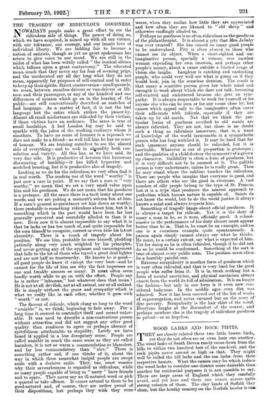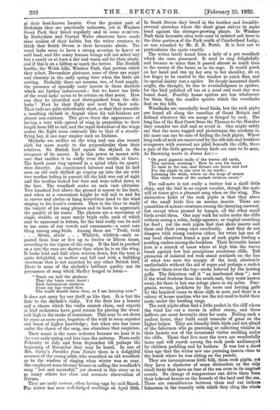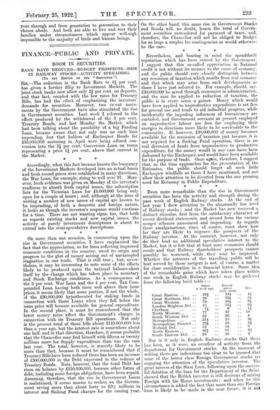WOOD LARKS AND ROCK PIPITS.
rpHEY are, closely related these -two little brown -birds, , IL yet they do- not oftelesee.or even hear one another. The wood tasks -of South Devon rarelycome-down from the hille -to- within. two hundred feet' of the sea-level, _and the . rock pipits never ascend' so high as.' that: They might: !well be called the- hill larks 'and the•sea larks from their: respective haunts. What the causes may be .which induce the wood larks to consider one, district more desirable than:- another for residential purposes it 'is not possible, to say., There are large areas' of England which _ they, carefully avoid, and yet here and there one comes across., quite strong -colonies. of them, The clay lands of- Suffolk they shim.; butithe-bee.thy.country on the Norfolk border 'is one* of their beat-known haunts.- Over the greater part of Berkshire they are• practically unknown, yet in Windsor Great Park they breed regularly and in some ni In Derbyshire and Central Wales observers have made close studies of their habits, but the writer ventures to think that South Devon is their favourite abode. The wood larks seem to have a strong aversion to heavy or cold land, and like many human beings will not select any but a sandy or at least a dry and warm soil for their abode, and if this is on a hilltop so much the better. The Norfolk heaths, the Welsh hills, Windsor Park, that portion which they select, Devonshire plateaux, none of these are soppy and clammy in the early spring time when the birds are nesting. - Probably there are reasons, too, of food supply, the presence of specially -tasty insects in these districts which are further inducements ; but we know too little of the wood larks' menu to be certain on that point. How can they be identified and distinguished from the sky- larks ? First by their flight and next by their note. Their tails are quite ridiculously short, so that they resemble a moulting skylark in August when his tail-feathers are almost non-existent. This gives them the appearance of having a very wide spread of wing in proportion to their length from bill to tail, and the rapid downbeat of the wings makes the flight seem curiously like to that of a steady- flying bat, if one may employ such an Irishism.
Skylarks are swifter on the wing and can also mount aloft far more nearly to the perpendicular than their relatives. No British bird equals the skylark in the steepness of its ascent. It is this power to mount with ease that enables it to outfly even the merlin at times. The hawk must ring*upward in a spiral while its quarry rises directly. An experienced falconer said that he had seen an old cock skylark go singing up into the air with two merlins toiling in pursuit till the lark was out of sight and the merlins looked but dots and were called down to the lure. The woodlark scales no such vast altitudes. Two hundred feet above the ground is nearer to his limit, and when at a convenient height he will sail to and fro in curves and circles or hang kestrelwise head to the wind singing to his heart's content. Then is the time to study the varietj, of his song phrases and to learn to appreciate the quality of his tones. The phrases are a succession of single, double, or more rarely triple calls, each of which may be expressed in letters, for the bird really can be said to use some of our vowels and consonants—a most rare thing among song-birds. Among them are " Twee, twee . . . Sewer, sewer . . . Wheeyfr, wheeyil—each re- peated from four or five up to twelve or fifteen times, according to the vigour of the song. If the bird is perched on a tree the runs are shorter than when he is on the wing. It looks bald and dull when written down, but the tone is quite delightful, so mellow and full and with a bubbling sweetness that is not matched by any other British bird. There is none of the skylark's brilliant quality nor its joyousness of song which Shelley longed to learn- " Teach me half the gladness
That thy brain must know : Such harmonious madness From my lips would flow. The world should listen then, as I am listening now."
It does not carry far nor thrill us like that. It is but the flute to the skylark's violin. Yet the flute has a beauty and a charm which the violin cannot claim, and experts In bird orchestras have good reason for placing the wood- lark high in the ranks of musicians. This may be set down by some as mere pose begotten of the wish to seem superior and boast of higher knowledge ; but when one has come under the charm of the song, one abandons that suspicion.
Their music is the more welcome because we hear it in the very early spring and late into the autumn. From early February to July and from September till perhaps the beginning of December they may be heard. In one of Mrs. Gatty's Parables from Nature there is a delightful account of the young robin who consulted an old woodlark as to the wisdom of singing when winter was so near. She employed some literary licence in calling the woodlark's song "low and mournful,' yet showed in this story as in PO many others her close and accurate observation of Nature.
They are early nesters, often having eggs by mid-March. writer has seen well-fledged nestlings on April 26th. In South Devon they breed inthe heather and bramble- covered stretches where the short- grase strives to make head against the stronger-growing plants. In Windsor Park their favourite sites were near to isolated oak trees in the drier portior s of the Park south of Cumberland Lodge, as was recorded by Mr. E. E. Pettit. It is best not to particularize the spots exactly. The writer lately heard from a lady of a pet woodlark which she once possessed. It used to sing delightfully and became so tame that it passed almost as much time in the rooms of the house as in its cage. It would perch on her hand and run up her arm to her shoulder, sit on her finger to be carried to the window to catch flies, and its special dainty was a spider. Its deeply-lamented death might, she thought, be due to overindulgence in spiders, for the bird polished off ten at a meal and next day was found dead. Possibly house spiders are less wholesome for them than the smaller species which the woodlarks find on the hills.
Woodlarks are essentially local birds, but the rock pipits are found all along the coastline of Great Britain and Ireland wherever the sea merge is fringed by rock. The long line of the East Coast from the Thames to the Humber they consider too dull and so avoid it. One might safely say that the more rugged and picturesque the seashore is, the more can one be sure of finding the rock pipits. Where long reefs of rock are uncovered by the ebb tide and boulders overgrown with seaweed are piled beneath the cliffs, there a pair of the little greeny-brown birds are sure to be seen, As Browning wrote in James Lee :— " Oh good gigantic smile o' the brown old earth, This autumn morning ! How he sets his bones To bask in the sun, and thrusts out knees and feet For the ripple to run over in its mirth :
Listening the while, where on the heap of stones The white breast of the sealark twitters sweet."
The call-note is not really a twitter but a shrill little chirp, and the bird is no expert vocalist, though the male will at times give a pleasant song when on the wing. The distinctive habit of the rock pipits is that they alone of the small birds live on marine insects. There are quantities of minute creatures among the decaying seaweed, but except when pressed by hunger, all the other small birds avoid them. One may walk for miles under the cliffs without seeing a robin, hedge-sparrow, or wagtail searching for food ; yet the rock pipits find that shore insects suit them and their young ones excellently. And they do not disagree with young cuckoos either, for twice has one of i our local observers found a pa of rock pipits feeding a nestling cuckoo among the boulders. Their favourite haunt here is a stretch of coast where at high tide the waves break against low but precipitous sandstone cliffs. Tall pinnacles of isolated red rock stand sentinels on the line of what was once the margin of the land, absolutely unclimbable without the aid of ropes and perhaps a rocket to throw them over the top—rocks beloved by the herring gulls. The fishermen call it ` an ironbound shop " ; and if the wind freshens from the south-east, they must hasten away, for there is but one refuge place in six miles. Pere- grines, ravens, jackdaws by the score and herring gulls by the hundred come to these digs to nest, and there is a colony of house martins who use the red marl to build their nests under the beetling crags. The rock pipits often find a little pocket in the cliff where the wind has cut a recess in softer strata, and these hollows are most favourite sites for nests. Failing such a perfect home, they build amid tussocks of grass on the higher ledges. They are friendly little birds and not afraid of the fishermen who go prawning or collecting winkles in their haunts nor of the occasional visitor strolling under the cliffs. Those that live near the town are wonderfully tame and will search among the rock pools undismayed by children paddling and by bathers. It was but a shorb time ago that the writer saw one pursuing insects close to the bench where he was sitting on the parade. They are inconspicuous little folk, these rock pipits, yeb they have a character of some distinction as the only small birds that have no fear of the sea even in its angriest moods. No change of temperature can drive them from their beloved homes on the bounds of the land and the sea. There are resemblances between them and our inshore fishermen in the tenacity with which they cling the whole year through and from generation to generation to their chosen abode. And both are able to live and rear their families under circumstances which appear well-nigh impossible to the majority of birds and. human beings.




































 Previous page
Previous page